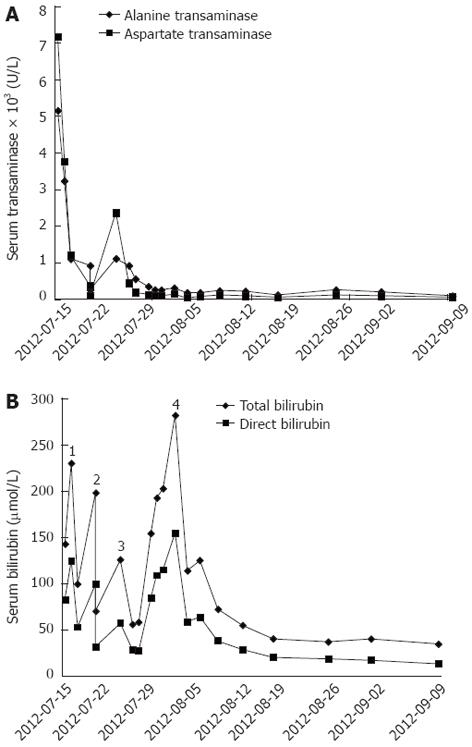Copyright
©2012 Baishideng Publishing Group Co.
World J Gastroenterol. Dec 21, 2012; 18(47): 7122-7126
Published online Dec 21, 2012. doi: 10.3748/wjg.v18.i47.7122
Published online Dec 21, 2012. doi: 10.3748/wjg.v18.i47.7122
Figure 1 Laboratory test results of physical examination.
A: Blood concentration of transaminases markedly decreased after artificial liver support (ALS)-plasma exchange, increased after liver transplantation due to ischemia reperfusion injury, and reached a peak on post-transplantation day 2, then decreased gradually to normal; B: Blood concentration of bilirubin. There are four marked peaks: bilirubin increased due to fulminant liver failure and decreased after two ALS-plasma exchanges, forming peaks 1 and 2; bilirubin increased after liver transplantation due to ischemia reperfusion injury and reached a peak, forming peak 3; bilirubin increased markedly because of the intracholedochal hematoma and decreased after percutaneous transhepatic intervention, forming peak 4.
- Citation: Qin JJ, Xia YX, Lv L, Wang ZJ, Zhang F, Wang XH, Sun BC. Successful disintegration, dissolution and drainage of intracholedochal hematoma by percutaneous transhepatic intervention. World J Gastroenterol 2012; 18(47): 7122-7126
- URL: https://www.wjgnet.com/1007-9327/full/v18/i47/7122.htm
- DOI: https://dx.doi.org/10.3748/wjg.v18.i47.7122









